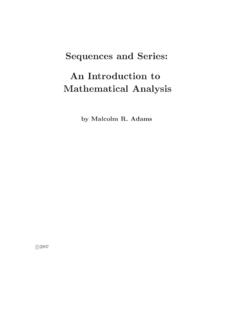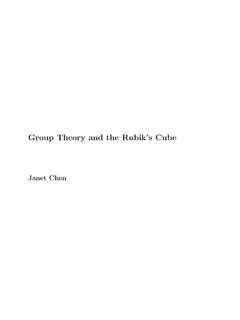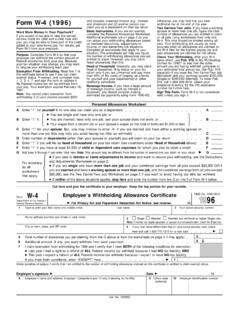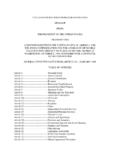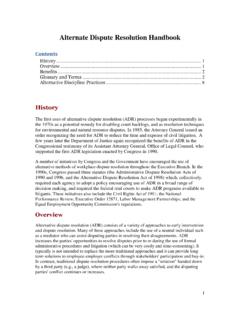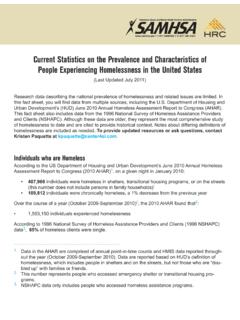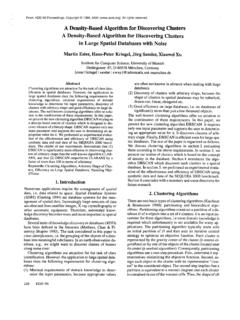Transcription of The residue theorem and its applications
1 The residue theorem and its applicationsOliver KnillCaltech, 1996 This text contains some notes to a three hour lecture in complex analysis given at Caltech. The lectures start fromscratch and contain an essentially self-contained proof ofthe Jordan normal form theorem , I had learned fromEugene Trubowitz as an undergraduate at ETH Z urich in the third semester of the standard calculus education atthat school. My text also includes two proofs of the fundamental theorem of algebra using complex analysis andexamples, which examples showing how residue calculus can help to calculate some definite integrals. Except for theproof of the normal form theorem , the material is contained in standard text books on complex analysis.
2 The notesassume familiarity with partial derivatives and line integrals. I use Trubowitz approach to use Greens theorem toprove Cauchy s theorem .[ When I had been an undergraduate, such a direct multivariable link was not in my complex analysis text books (Ahlfors forexample does not mentionGreens theorem in his book).]For the Jordan form section, some linear algebra knowledge is The residue theoremDefinitionLetD Cbe open (every point inDhas a small disc around it which still is inD). Denote byC1(D)the differentiable functionsD C. This means that forf(z) =f(x+iy) =u(x+iy) +iv(x+iy) the partialderivatives u x, u y, v x, v yare continuous, real-valued functions Let : (a, b) Dbe a differentiable curve inD.
3 Define thecomplex line integralZ f(z)dz=Zbaf( (t)) (t)dtIfz=x+iy, andf=u+iv, we haveZ f(z)dz=Zba(u x v y) +i(u y+v x)dtThe integral for piecewise differentiable curves is obtained by adding the integrals of the pieces. We alwaysassume from now on that all curves are piecewise {|z|< r}withr >1, : [0, k 2 ] D, (t) = (cos(t),sin(t)),f(z) =znwithk N,n zndz=Zk2 0einteiti dt=Zk2 0ei(n+1)ti dtIfn6= 1, we getZ zndz=1n+ 1ei(n+2)t|k2 0= 0 Ifn= 1, we haveR zndz=Rk2 0i dt=k 2 recall from vector calculus theGreen formulafor a vector field (u, v) inR2Z (u x+v y)dt=ZD(vx uy)dx dy ,whereDis the open set enclosed by closed curve = Dand wheredx dy=dxdyis thevolume formin theplane.
4 Writedz=dx+idy,dz=dx idyanddz dz= 2idx dy. Define forf C1(D) theorem (Complex Green Formula)f C1(D),D C, = f(z)dz=ZD f zdz dz .Proof. Green s theorem applied twice (to the real part with the vector field (u, v) and to the imaginary part withthe vector field (v, u)) shows thatZ f(z)dz=Zba(u x v y) +i (u y+v x)dtcoincides withZD f zdz dz=ZD12(ux vy) +i2(uy+vx) 2idx dy=ZD( uy vx)dx dy+i ZD(ux vy)dx dyWe check that f z= 0 u x= v y, v x= u right hand side are called theCauchy-Riemann differential Denote byC (D) the set of functions inC1(D) for which f z= 0 for allz D. Functionsf C (D)are ( theorem of Cauchy)f C (D),D C, = f(z)dz= f(z)dz=ZD f zdz dz= 0 Corollary (Cauchy s Integral formula)f C (D),Dsimply connected, = D.
5 For anya Df(a) =12 iZ f(w)dww Define for small enough >0 the setD =D\{|z a| }and the curve :t7 z+ eit. (BecauseDisopen, the setD is contained inDfor small enough ). Because = D we get by Cauchy s theorem f(w)w adw Z f(w)w adw= computeZ f(w)w adw=Z2 0f(z+ eit)a+ eit addt(a+ eit)dt=i Z2 0f(a+ eit)dtThe right hand side converges for 0 to 2 if(a) becausef C1(D) implies|f(a+ eit) f(a)| C Corollary (Generalized Cauchy Integral formulas)Assumef C (D)andD Csimply connected, and D= . For alln None hasf(n)(z) C (D)and for anyz / f(n)(z) =n!2 iZ f(w)dz(w z)n+ Just differentiate Cauchy s integral follows thatf C (D) is arbitrary often C (D\{a}) anda Dwith simply connectedD Cwith boundary.
6 Define theresidueoffataasRes(f, a) :=12 iZ f(z)dz .By Cauchy s theorem , the value does not depend (z) = (z a) 1andD={|z a|<1}. Our calculation in the example at the beginning of the sectiongives Res(f, a) = generalization of Cauchy s theorem is the following residue theorem :Corollary (The residue theorem )f C (D\{zi}ni=1),Dopen containing{zi}with boundary D= .12 iZ f(z)dz=nXi=1 Res(f, zi).Proof. Take so small thatDi={|z zi| }are all disjoint and contained inD. Applying Cauchy s theorem tothe domainD\Sn1=1 Dileads to the above Calculation of definite integralsThe residue theorem has applications in functional analysis, linear algebra, analytic number theory, quantum fieldtheory, algebraic geometry, Abelian integrals or dynamical this section we want to see how the residue theorem can be used to computing definite real first example is theintegral-sineSi(x) =Zx0sin(t)tdt ,a function which has applications in electrical engineering.
7 It is used also in the proof of theprime numbertheoremwhich states that the function (n) ={p n|pprime}satisfies (n) x/log(x) forx .Si( ) =Z 0sin(x)xdx= 2 Proof. Letf(z) =eizzwhich satisfiesf C (C\{0}). Forz=x R, we have Im(f(z)) =sin(x)x. Define forR > >0 the open setDenclosed by the curve =S4i=1 i, whereFigure 1 1:t [ , R]7 t+ 0 i. 2:t [0, ]7 R eit. 3:t [ R, ]7 t+ 0 i. 4:t [ ,0]7 Cauchy s theorem0 =Z f(z)dz=ZR eixxdx+Z 0eiReitReitiReitdt+Z Reixxdx+Z0 ei eit eiti eitdt .The imaginary part of the first and the third integral converge for 0,R both to Si( ). The imaginarypart of the fourth integral converges to becauselim 0Z 0ei eiti dt i .The second integral converges to zero forR because|eiReit|=|e Rsin(t)| |e Rt|fort (0, /2].)
8 Z 11 +x2dx= Proof. Takef(z) = 1 +z2which has a simple polea=iin the upper half plane. Define forR >0 the half-discDwith a hole which has as a boundary the curve =S2i=1 iwith 1:t [ R, R]7 t+ 0 i. 2:t [0, ]7 R analytic inD\{i}and by the residue theoremZ f(z)dz=ZR R11 +x2dx=Z 0iReitdt1 +R2 e2it= 2 i Res(f(z), i) = 2 i limz i(z i) f(z) = The second integral from the curve 2goes to zero forR .Letf, gbe two polynomials withn= deg(g) 2 + deg(f)such that the polesziofh:=f /gare not onR+ {0}.Z 0h(x)dx= nXi=1 Res(h(z) log(z), zi)Proof. Define forR > r >0 the domainDenclosed by the curves R r +with +:t [r, R]7 t+ 0 i. :t [R, r]7 t+ 0 i. R:t [0,2 ]7 R eit. r:t [0,2 ]7 r e apply the residue theorem for the functionh(z) log(z):Z h(z) log(z)dz=Z Rh(z) log(z)dz+Z rh(z) log(z)dz+Z +h(z) log(z)dz+Z h(z) log(z)dzBecause of the degree assumption,R Rh(z) log(z) 0 forR.
9 Becausehis analytic near 0 and log(z) goesslower to thanz 0 we get alsoR rh(z) log(z)dz 0 asr 0. The sum of the last two integrals goes to (2 i)R 0h(x)dxbecauseZ +h(z) log(z)dz= Z h(z)(log(z) + 2 i)dz .Z 0d a+ cos( )d = a2 1, a >1 Proof. Putz=ei . Thena+ cos( ) =a+z+z 12=2az+z2+ : 7 ei Z 0d a+ cos( )d =12Z2 0d a+ cos( )d =Z 12i2dz2az+z2+ the two zeros a a2 1 of the polynomial 2az+z2+ 1 the root +is in the unit disc and outsidethe unit disc. From the residue theorem , the integral is2 i1iRes(12az+z2+ 1, +) =2 + = a2 Jordan normal form for matricesAs an other application of complex analysis, we give an elegant proof ofJordan s normal form theoreminlinear algebra with the help of the Cauchy- residue (n,R) denote the set of realn nmatrices and byM(n,C) the setn nmatrices with complex M(n,C) thecharacteristic polynomialisdet( A) =kYi=1( i) simply write Ainstead of I A, whereIis the identity matrix.
10 The complex numbers iare called theeigenvaluesofAand idenote theirmultiplicities. ClearlyPki=1 i= matricesA, B M(n,C) are calledsimilarif there exists an invertible matrixSsuch thatA=S (Jordan normal form theorem )A M(n,C)is similar to a matrix [A1] 0..00 [A2] 0 0..00[Ak] whereAi= i1 1 i1 i are callednormal follows if all eigenvalues ofAare different, thenAis for 6= itheresolventmatrixR( ) = ( A) function 7 R( ) is analytic inD=C\{ i}in the sense that for alli, j, the functions 7 [R( )]ijareanalytic inD. The reason is that there exist polynomials(whereA(ij)are the matrices obtained by deleting thei th row and thej th column ofA), such that[R( )]ij= ij( )det( A).
